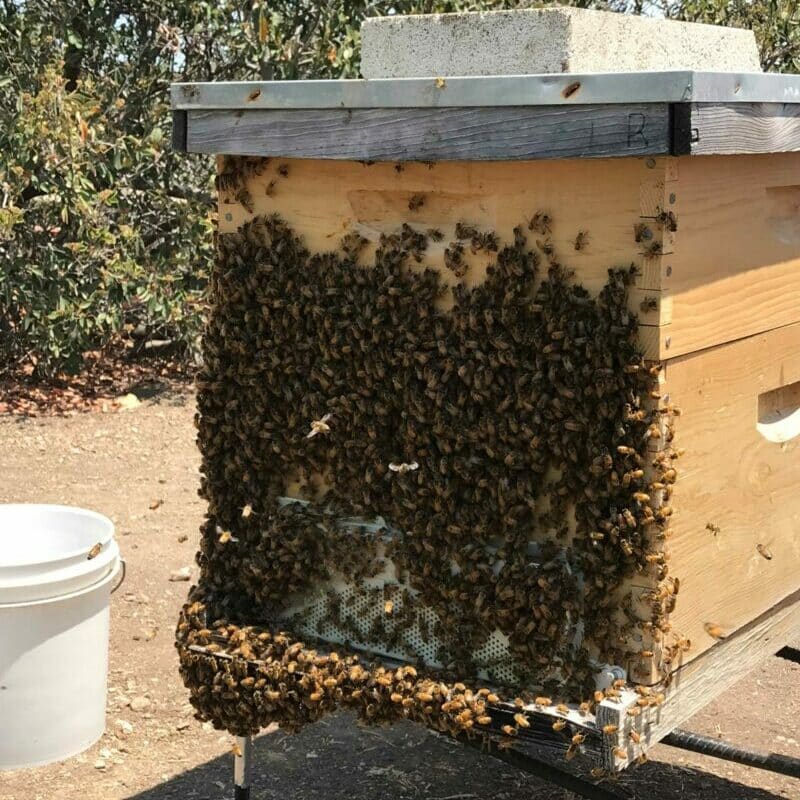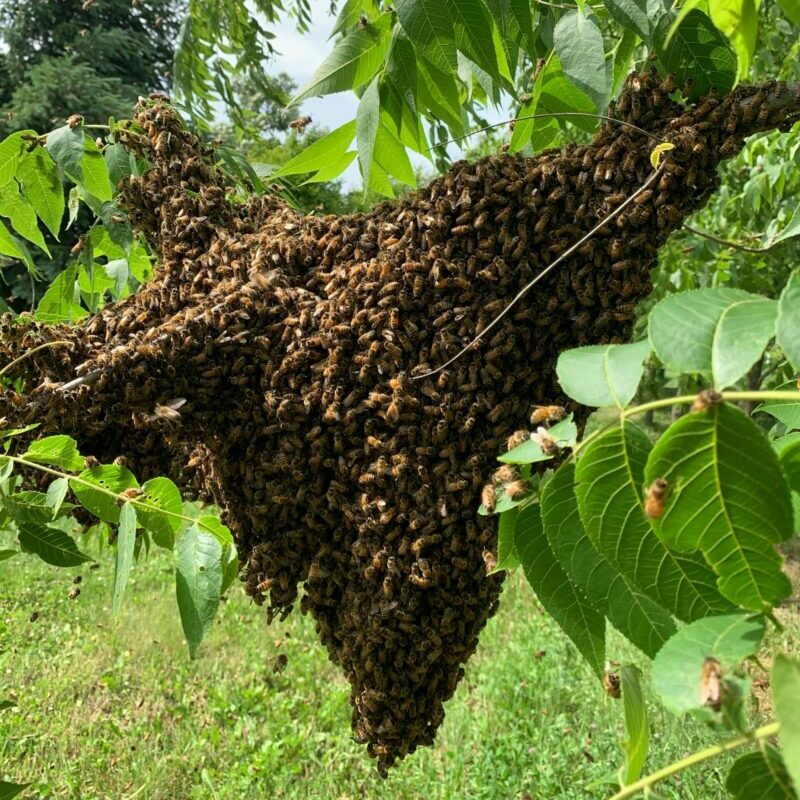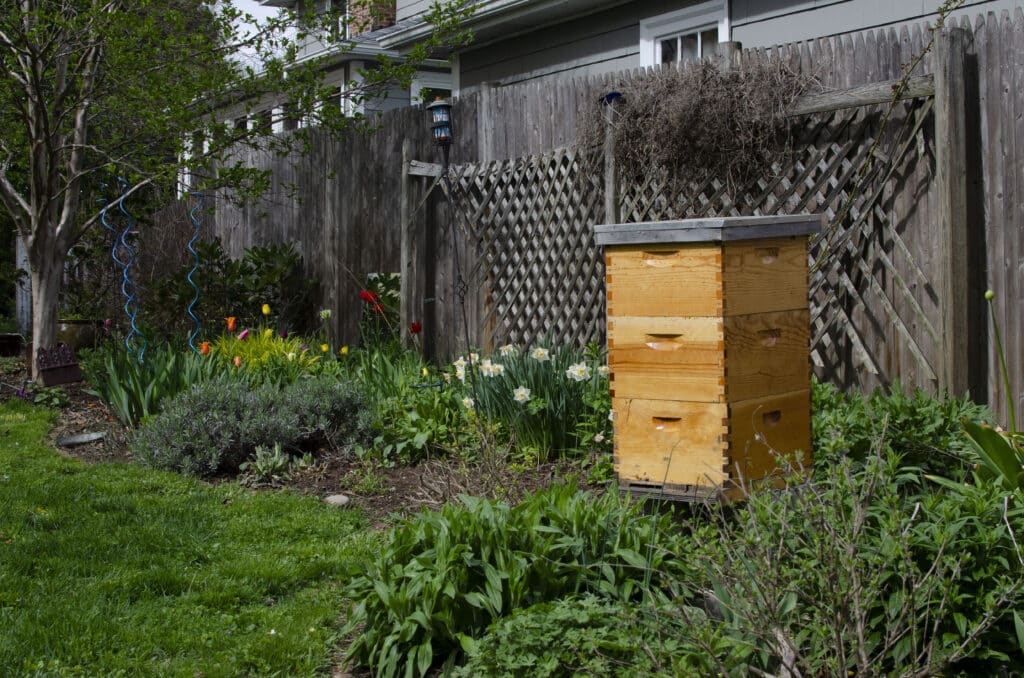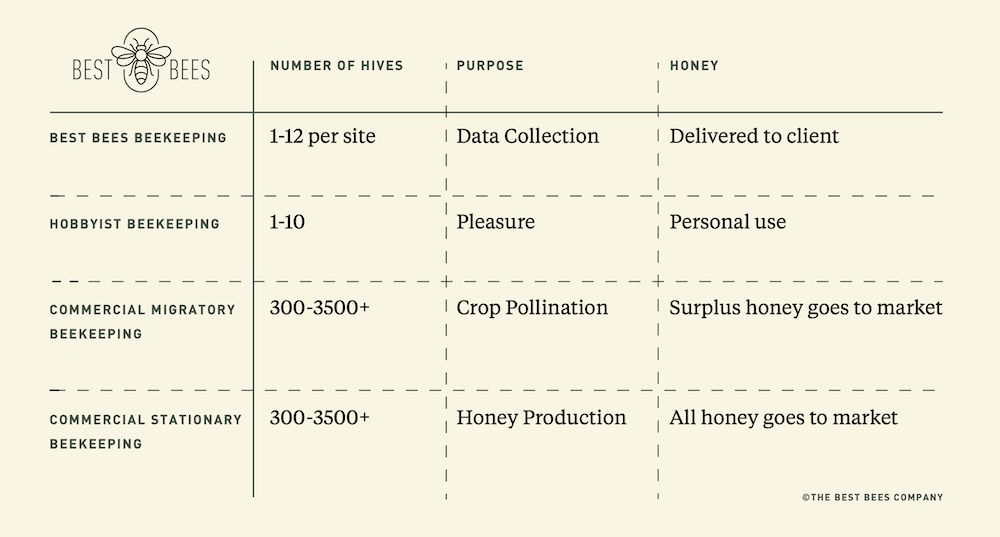Contents:
- Beekeeping in the summer
- How does heat affect honey bees?
- What is bee bearding?
- Why do bees beard?
- Bee bearding and Nectar Dearth
- What does bee bearding look like?
- Should you try to prevent bee bearding?
- Bee Bearding vs. Bee Swarming
- Bee Bearding vs. Bee Washboarding
- How can you help bees during the summertime?
- FAQs
Beekeeping in the Summer
Summer is often a favorite time for beekeepers and people who host beehives. During this time and in most areas, beekeepers will begin to harvest honey and gather valuable learnings from the hive in order to make sound observations for the rest of the season. Bees are incredibly self-sufficient creatures, and during these warm and humid summer months, you may witness bees clung to the exterior of a hive in a behavior called bearding.
–– Interested to know how the bees are doing? Download our State of the Honey Bee Report now ––
Continue reading as we chat with The Best Bees Company Staff Scientist Emily O’Neil for a deeper understanding of bee bearding, what it looks like, and why it happens.
How does heat affect honey bees?

“In the summer, the external temperature outside a hive has many effects on the internal environment of a hive. Temperature and humidity regulation is extremely important in the colony’s internal environment as successful/healthy brood rearing and effective honey evaporation require certain levels of humidity and temperature. For healthy brood development, the internal temperature of a hive must be kept between 90-97 degrees Fahrenheit.”
What is bee bearding?
“Bearding refers to the behavior of bees when they are assembled on the outside of the hive during hot and humid weather. These bees may cling to the outside of the brood boxes, hang from the bottom board, or even cluster around the entrance.”
Why do bees beard?

“There are several conditions that lead to bearding such as high temperatures, high humidity, over-crowding (high population of bees), poor ventilation and/or a combination of these factors. The bees form beards in an effort to keep the brood nest from becoming overheated.
If too many bee bodies are covering the brood on a hot day, fanning may not be sufficient to keep the brood cool. By hanging around on the outside instead of the inside, they decrease the heat load, decrease congestion, and increase the ventilation space, allowing for fanning to help cool the hive.”
Emily also notes that bearding can be a signal to beekeepers that the hive needs more space, such as another box or removal of filled frames for empty ones.
Bee bearding and Nectar Dearth
While bee bearding can be a sign of temperature control by bees, it can also be closely related to a shortage of nectar-producing flowers, called nectar dearth. According to HoneyBeeSuite.com, bees come and go from their hives at an extraordinary rate, but during a dearth on a hot summer day, a beard is likely to form. This is because there is nothing outside the hive to collect, leading to an increase in the hive temperature and causing the bees to collect on the outside of it.
What does bee bearding look like?
Bee bearding typically looks like a cluster of bees gathered around the outside of a hive, sometimes even forming what looks like a beard at the bottom of the hive entrance. When bees are bearding, you will also see them “fanning” their wings in an effort to cool down the temperature of the hive and increase ventilation.
Should you try to prevent bee bearding?
Bee bearding is a completely normal behavior and should not be prevented if seen! Instead, let the bees continue cooling down their hive–Emily O’Neil recommends adding another box to the hive or removing the entrance reducer to help increase ventilation. However, it is crucial that you first determine if the bees are bearding or if they are swarming.
Bee Bearding vs. Bee Swarming

Bee bearding and swarming may appear very similar, as they are both large groups of bees clustered together, but the two behaviors have different meanings. According to Emily O’Neil, the main way to distinguish bearding and swarming is the location of the cluster: If the cluster is located in front of the hive, then those bees are bearding.
Emily also notes that you can tell that a certain behavior is not a bee swarm by observing the amount of activity from the bees at the front of the hive entrance. If there is a large cloud of bees flying around the hives, that is a swarm that is preparing to go outside of its original hive and to a new location. For more information about bee swarms and what to do if you see one, click here.
Bee Bearding vs. Bee Washboarding
While no one knows exactly why bees “washboard”, beekeepers have continued to study this behavior that occurs during warmer months. Bees are washboarding when they are outside of a hive (similar to bearding), but in this case, they are more spaced out and are performing a back and forth or swaying motion.
Carolina Honeybees notes that washboarding is only done by worker bees, as drones do not participate, and that this activity always occurs near an exterior entrance of a beehive. While there is no clear answer as to why bees do this, beekeepers have developed several theories.
How can you help bees during the summertime?

With bee populations continuing to decline year after year, it’s on all of us to do our part in helping improve their health. This summer, consider becoming an advocate for these pollinators by planting bee-friendly flowers in your garden, avoiding the use of pesticides in your yard, supporting local beekeeping efforts, and even hosting a data-yielding beehive of your own!
To learn more about how you can make a tangible impact on the health of honeybees and other pollinators from your own backyard or at your business, get in touch with The Best Bees Company here.
FAQs
Q: What is bee bearding?
A: Bearding refers to the behavior of bees when they are assembled on the outside of the hive during hot and humid weather.
Q: Why do bees beard?
A: Bees beard because of high temperatures, high humidity, over-crowding (high population of bees), poor ventilation and/or a combination of these factors.
Q: What does bee bearding look like?
A: Bee bearding often looks like a cluster of bees gathered around the outside of a hive and fanning their wings, sometimes even forming what looks like a beard at the bottom of the hive entrance.
Q:Why do bees beard at night?
A: Bees beard at night to keep the internal temperature and humidity down inside the hive.
Q: Why do bees beard in the rain?
A: Bees beard in the rain to help regulate/reduce the temperature and humidity inside the hive while the weather is a little cooler outside.
Q: Should I remove the entrance reducer if bees are bearding?
A: Yes. Removing the entrance reducer of a beehive while bees are bearding can help increase ventilation inside the hive.






